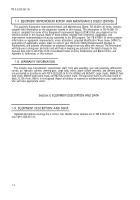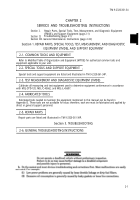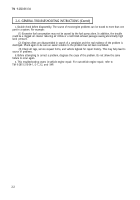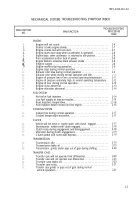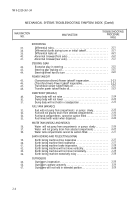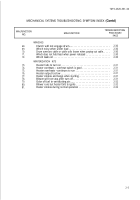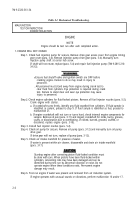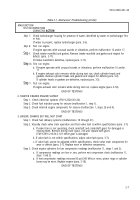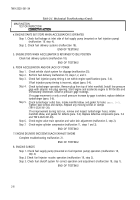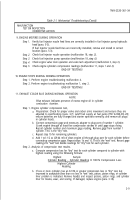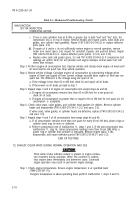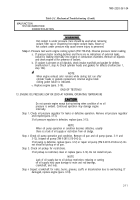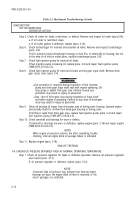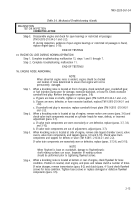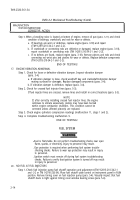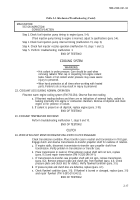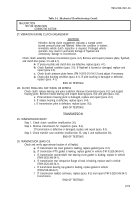TM-9-2320-361-34 - Page 25 of 764
TM 9-2320-361-34
Table 2-1. Mechanical Troubleshooting (Contd).
MALFUNCTION
TEST OR INSPECTION
I
CORRECTIVE ACTION
c.
e.
If one or more cylinders had an 8-10% or greater loss in both “wet” and “dry” tests, the
compression loss is on top of engine. Remove head(s) and inspect valves, valve seats and
guides, and cylinder head gasket(s). Repair (TM 9-2815-210-34-2-2) or replace defective
parts (para. 3-3).
If repairs of b and/or c do not sufficiently restore engine to normal operation, remove
rocker arm covers (para. 3-6), inspect for camshaft, tappets, and pushrod defects. Repair
(TM 9-2815-210-34-2-2) or replace defective parts (paras. 3-7,3-8, and 3-10).
Replace valve seals and guides (para. 3-3 and TM 9-2815-210-34-2-2) if compression test
readings are within limits for all cylinders and engine develops normal power but still
shows blue exhaust.
Step 3. Perform engine oil consumption test. Operate vehicle and closely check engine oil level until
oil level reaches one quart low. Stop vehicle operation.
Step 4. Record vehicle mileage. Calculate engine oil consumption by subtracting mileage when
engine oil level was topped off from current mileage recorded when engine oil level was one
quart low. The difference is the mileage using one quart of oil.
a. If the mileage is less than 60 mi (96 km) check for and repair all oil leaks.
b. If there were no oil leaks, proceed to step 7.
Step 5. Repeat steps 3 and 4 of engine oil consumption test except steps 4a and 4b.
a. If engine oil consumption remains less than 60 mi (96 km) for a one quart oil,
check all oil seals.
b. If engine oil consumption is greater than or equal to 60 mi (96 km) for one quart oil, oil
consumption is acceptable.
Step 6. Check valve seats, valve guides, and cylinder head gaskets for defects. Remove cylinder
heads and disassemble (TM 9-2815-210-34-2-1,-2-2, and para. 3-3).
If valve seats, valve guides, or cylinder heads are defective, replace (TM 9-2815-210-34-2-2
and para. 3-3).
Step 7. Repeat steps 4 and 5 of oil consumption test except steps 4a and 4b.
a. If oil consumption remains more than one quart for every 60 mi (96 km), piston rings or
cylinder bores may be worn or defective.
b. Perform compression test of malfunction 11, steps 1 and 2. If the wet compression test,
malfunction 11, step 1d, raises compression readings more than 50 psi (345 kPa), a
piston ring or cylinder bore problem is indicated. Remove engine (para. 3-18),
disassemble, and repair defective parts (TM 9-2815-210-34-2-1 and -2-2).
END OF TESTING!
12.
EXHAUST COLOR WHITE DURING NORMAL OPERATION AND IDLE
CAUTION
Thick white smoke indicates coolant is present in engine combus-
tion chambers during operation. When this condition is evident,
shut engine down immediately and determine cause. Continued
engine operation may result in permanent engine damage.
Step 1. Check engine temperature. Ensure engine temperature is at specified level
(TM9-2320-361-10).
If engine temperature is above operating level, perform malfunction 1, steps 9 and 10.
2-10
Back to Top

